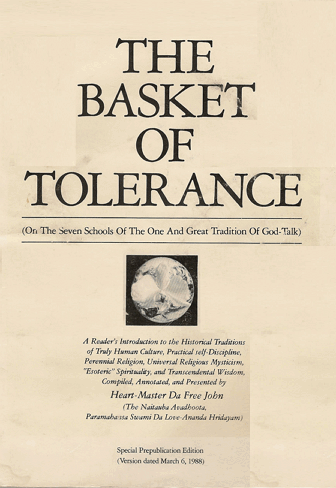|
The Hinayana Tradition (Basically
Associated with the Sixth Stage of Life and, at Least
Potentially, with the Seventh Stage of Life)
Adi Da Samraj – The
Basket of Tolerance, pp.
45-46.

Even though classical (“Hinayana”
and, later, “Theravada”) Buddhism is broad enough in its
implications to qualify as a tradition in the total context
of the first six stages of life (and, in principle, even the
seventh), it is basically a “realistic” tradition that seeks
to release individuals from the common limits associated
with the first three stages of life.
Classical Buddhism was originally a
phenomenon that was designed in direct contradiction to the
popular ritualism of its day, and it still functions as a
counter to the popular ritualistic (and “idealistic”)
culture commonly associated with the first three stages of
life. That is to say, whereas popular religious culture
seeks (by appealing to the “Creator-God”, or to cosmic
powers in general) to grant “good karma” (or thee common
goods and fortunes of life) to the individual whose beliefs,
social behavior, and ritual performances are “correct” (from
the popular religious point of view associated with the
first three stages of life), classical Buddhism is motivated
exactly toward the opposite purpose. Thus, classical
Buddhism seeks (by specifically not appealing to any
“Creator-God”, or to any cosmic powers at all) to liberate
the (rather ascetical) practitioner from all “karma”
(whether “good” or “bad”), or all causes and effects within
the human and cosmic domain.
And the classical Buddhist “method”
is also the opposite of the basic popular religious method
associated with the first three stages of life. That is to
say, it avoids cosmic mythologies (or cosmically oriented
and “God”-oriented mythologies) and the technique of ritual
(since ritual is a “karmic” act that seeks to “cause” good
“karmic” effects). However, classical Buddhism does retain
an aspect of popular religious method. It is the technique
of morally effective behavior. Even so, the classical
Buddhist use of behavioral discipline is not (in principle)
intended for the sake of making “good karma”, but it is
intended (at least in its ultimate purpose) for the sake of
not making any more “karma”. That is to say, the “moral”
discipline of classical Buddhism is basically ascetical,
rather than “creative”.
Classical Buddhism is basically a
revolutionary ascetical approach to the ordinary “karmic”
realities of the first three stages of life, and its
“realistic” concern is release from suffering (rather than
the popular “idealistic” concern for a “good”
fate).
Classical Buddhism is a kind of
semi-popular ascetical “realism”, specifically opposed to
all forms of popular religious “idealism”. However, the
ultimate fulfillment of that “realistic” method (based in
the first three stages of life) is a kind of sixth stage
(and, at least potentially, even seventh stage) Realization
of the Ultimate Transcendental (or “Nirvanic”) Condition.
Therefore, classical Buddhism may be viewed as a kind of
sixth stage “realistic” philosophy and practice that
Realizes (or would Realize) the same “Truth” Realized (or to
be Realized) in all “idealistic” sixth (or sixth to seventh)
stage traditions and schools, including the “idealistic”
traditions and schools of Mahayana (and Tibetan, or
Vajrayana) Buddhism and the various schools (such as Advaita
Vedanta) of fully advanced Hinduism that developed from the
Upanishadic tradition.
The “idealistic” traditions and
schools associated (ultimately) with the sixth and seventh
stages of life are “idealistic” not only because they
generally remain compatible with the basic methods,
purposes, and language of popular religious culture (or the
“exoteric” culture associated with the first three stages of
life), and even of all progressively “esoteric” forms of
culture (that develop beyond the context of the first three
stages of life), but primarily because they directly affirm
and describe “That” Which Is Ultimate Truth, whereas the
“realistic” language of classical Buddhism generally, and
rather rigorously, avoids “Ultimate” descriptions and
definitions. (Also, the “Ultimate Truth” of the “idealistic”
sixth, or sixth to seventh, stage traditions and schools
may, in some fundamental sense, be directly intuited even at
the beginning, or in any progressive moment, of sixth stage
practice, or even earlier, whereas the classical Buddhist
“Nirvana” can only be Realized at the “end”, or in the event
of final and complete fulfillment of the ascetical
process.)
Indeed, classical Buddhism was (and
is) a revolutionary (but still rather conventional) effort
based on the everyday presumed “realism” of human life,
whereas the “idealistic” traditions and schools of sixth
stage (and, at least potentially, seventh stage) practice
have always represented a truly “Radical” and
non-conventional comprehension of existence (that readily
moves beyond.the common limits of the first three stages of
life and, ultimately, beyond even all of the first six
stages of life).
The basic source of (or historical
precedent for) all advanced “idealistic” traditions was (and
is) the Upanishadic movement (which developed in the same
general historical period in which the earliest form of
classical Buddhism developed). And even though the
Upanishadic era in India produced a variety of schools that
were advanced beyond the common popular religious movements
of the ancient (or Vedic) period, the principal school or
tradition that characterized the Upanishadic movement was
the sixth (and, at least potentially, seventh) stage
tradition that, in the modern era, appears in the form of
such traditions or schools as Advaita Vedanta.
Adi Da Samraj – The
Basket of Tolerance, pp.
45-46.

|
